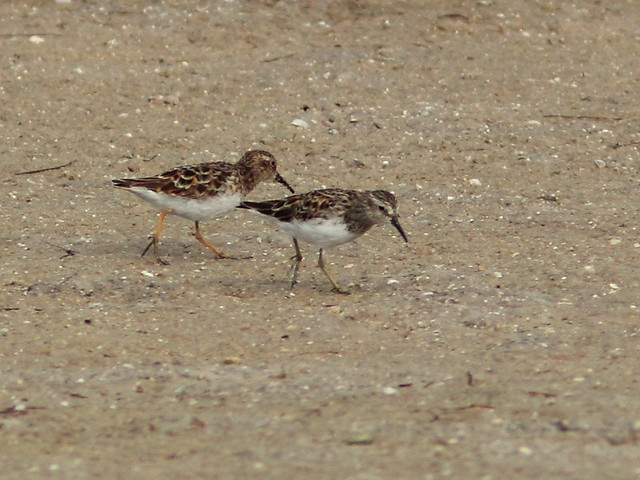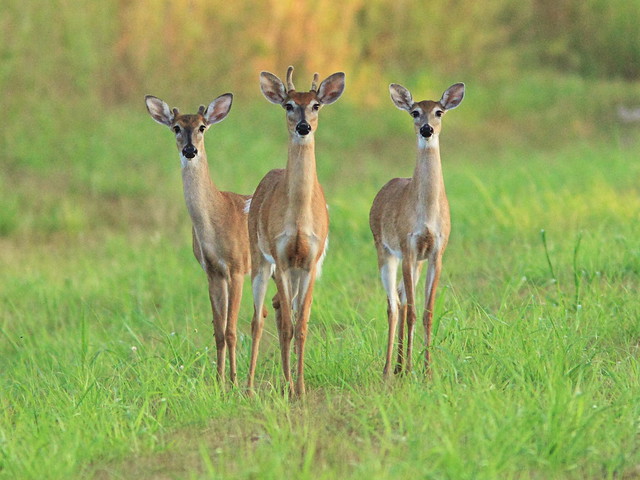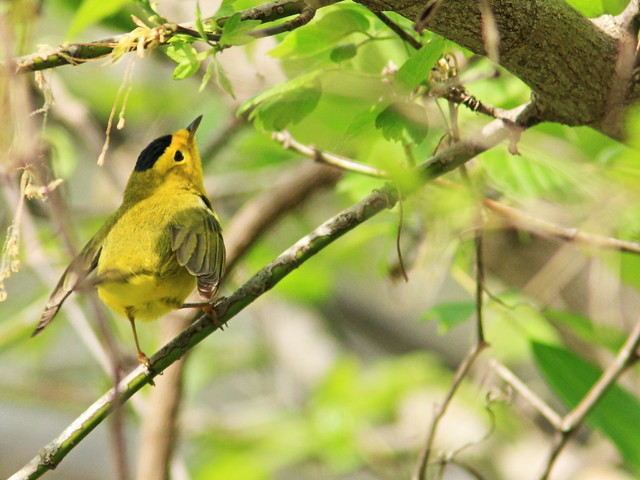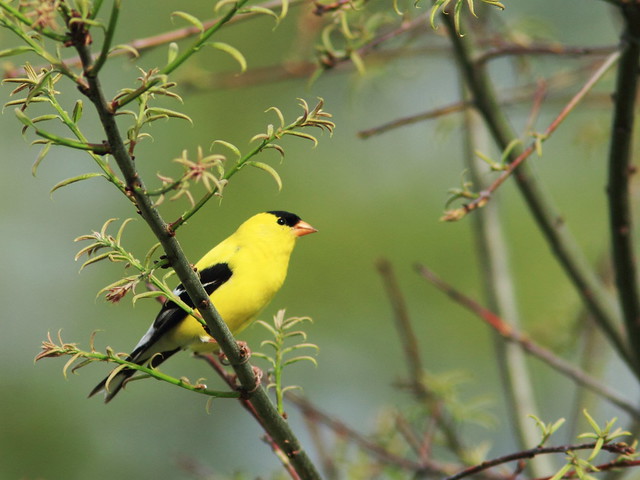Barely visible, an Anhinga is drying its spread wings in a tree past the far end of the boardwalk at Chapel Trail Nature Preserve in neighboring Pembroke Pines, Florida:
 A pair of Anhingas appear to be in the early stages of courtship at the heron rookery in our local wetlands.
A pair of Anhingas appear to be in the early stages of courtship at the heron rookery in our local wetlands.
The male Anhinga sports a white crown as it transforms into breeding plumage:



The view of his back shows the corrugations in the central tail feathers as well as scapulars. Since it "flies" underwater to catch fish, these may act like "spoilers" on an aircraft to break down laminar flow and thus reduce drag:

The female of the pair has a buffy head, neck and chest:


MACRO of Male with green "goggles" at height of breeding season:

A female in breeding condition also has the green flesh around her eyes:

A male Anhinga at Corkscrew Swamp shows the feather corrugations as well as the oil gland at the base of its tail, which it uses to preen its feathers:

A young Anhinga preens on our back lawn. The immature plumage is dull brown:

This young Anhinga is drying its wings on a the post at the end of the boardwalk at Chapel Trail:

Anhinga on decoy in our back yard lake:

Anhinga casting a fine REFLECTION:

Anhinga feeding young:


This Anhinga seems to be admiring her reflection in the canal:

A closer look:

Slide show-- Anhinga eating a big fish:
If video does not display, click here-- https://youtu.be/nTkc3AfZHnQ
Short video-- Anhinga threat display:
If video does not appear, click here-- https://youtu.be/4G62BcJ_B8c
Excellent video by and property of Richard Kern, shared under terms of the Standard You Tube License. Especially watch for the male's magnificent breeding display. Its transformation reminds me of a Bird of Paradise:
If video does not display, click here-- https://youtu.be/EfoqPIcSQCQ
= = = = = = = = = = = = = = =
Linking to Misty's CAMERA CRITTERS,
Linking to Eileen's SATURDAY'S CRITTERS,
Linking to GOOD FENCES by Tex (Theresa).
Linking to SKYWATCH FRIDAY by Yogi, Sylvia and Sandy
Linking to WEEKEND REFLECTIONS by James
Linking to BirdD'Pot by Anni
Linking to Wild Bird Wednesday by Stewart
________________________________________________
Please visit the links to all these memes to see some excellent photos on display
________________________________________________
We are accustomed to seeing white wading birds in our south Florida back yard lake. The most common of these is the White Ibis. Adults are mostly white, with black wingtips.
Not herons but rather more closely related to spoonbills, they have strikingly red bill and legs.

During mating season, around the middle of winter, the males squabble to establish dominance.

Tactile feeders, the ibis probes into the mud and clamps down upon prey. This one just caught a crayfish.

Egrets are also common. Great Egrets might be seen at any time. They are sight feeders and either wait patiently or stalk for prey such as small fish, crustaceans and insects.

They are quite wary, and I find it difficult to obtain a closeup. Note the long bright orange-yellow bill and all-black legs.

The smaller Snowy Egret appears sporadically. A more restless feeder, it quickly traverses the shoreline in search of food. Its bill is black and its "golden slippers" contrast with mostly black legs. It startles prey by stirring the water with its yellow feet.

Even smaller is the Cattle Egret, distinguished by its short yellow bill and dark legs. Rather than hunting in the water, it searches our garden for insects and lizards.

The Cattle Egret develops rusty plumes on its head and breast during breeding season.

We usually have Little Blue Herons on the lake, but most are dark adults. During their first year they are white, and we must take a closer look to postively identify them. Deliberate hunters, they seem to be near-sighted as they walk slowly with their bills almost touching the water (or the grass, as this one is after a dragonfly). Greenish legs and a light bill with a dark tip are distinctive features.

Less common, especially in recent years, is the Wood Stork. A tactile feeder, it slowly moves along with half-open bill. Like the Snowy Egret, it stirs the water with its feet, which are bubble-gum pink.

Rare indeed is the visitor which occasioned this post. Look closely and compare it with the white waders described above.
 It is a "Great White Heron," a subspecies of the Great Blue Heron. Admittedly, I almost passed it off as a Great Egret when I first saw it across the lake. However it seemed bulkier and had a habit of roosting in one spot for a long time, even up to an hour, so I took a closer look. This was my first photo, which confirmed my suspicions.
It is a "Great White Heron," a subspecies of the Great Blue Heron. Admittedly, I almost passed it off as a Great Egret when I first saw it across the lake. However it seemed bulkier and had a habit of roosting in one spot for a long time, even up to an hour, so I took a closer look. This was my first photo, which confirmed my suspicions.

Known to breed in Cuba and some of the Caribbean Islands as well as the Yucatan Peninsula and on islands off the coast of Venezuela, the Great White Heron's North American range is almost exclusively limited to the Florida Keys and the tip of the Florida south of Miami.
Its upper mandible is dark, contrasting with the orange lower bill, quite identical to the common "blue" form of the Great Blue Heron.This bird's thighs are light, and its lower legs are darker but not black.


This bird was earlier considered to be a variant color morph of the nominate Great Blue Heron (Ardea herodias herodias), but is actually a distinct subspecies, Ardea herodias occidentalis. The blue and white subspecies occasionally interbreed.
Since Great Egrets are sometimes misidentified as Great White Herons, I had the unusual opportunity to photograph both individually from the same distance, walking across a lawn on the opposite side of the lake. Both photos were taken at a range of 140 meters and nearly the same angle. They exhibit the larger size and more robust body of the Great White Heron.
Great White Heron at 140 meters:
 Great Egret at 140 meters:
Great Egret at 140 meters:

The Great White Heron prefers coastal waters and rarely ventures north of its habitual range, but has been documented along the Atlantic into New England and even Canada. Inland sightings are quite rare. Our home is 18 miles away from the ocean, and this was the first one to visit our yard.
The Great White Heron spent much time on our back lawn, remaining for three days straight, then after a two day absence it reappeared. It was so close that even after I backed away I could not fit the entire bird in the video frame!
Although our granddaughter Graciela summed up her Florida visit very nicely in her recent guest blog, I had to cut her words short before she really got into describing the sights in Ding Darling National Wildlife Refuge in Sanibel Island, Florida.
Here are a few images from this marvelous place. Unfortunately each of our three stops in the Refuge occurred at time of high or incoming tide, not good timing for wading birds. Yet, we got to see...
...Roseate Spoonbills...

...Least Sandpipers...

...Semiplamated Plovers...

...Spotted Sandpipers (this one was stalking a crab)...

...and a stunning Northern Cardinal.

OK, I'm boring you but I must share this photo of a mischievous Fish Crow caught in the act of raiding a bicyclist's camera bag.

I obtained a mug shot of the culprit.

Upon returning to the wetlands next to our Florida home I captured a pleasant image of three young White-tailed Deer. The wind was in my favor and they stared at me for a long time before bolting off (click on the image for a slide show of many more photos in my FLICKR collection).

There followed our unplanned trip to Arizona for the memorial Mass of Celebration of the life of Mary Lou's brother, who passed away on Easter Sunday. From Phoenix we flew directly to our second home in NE Illinois. Migration in Florida had been rather slow in our neighborhood, so I looked forward to catching up with the northbound songbirds.
Listen to the bird sounds in this brief video clip, along the shore of the Fox River in Batavia, Illinois. If it does not display in the space below, visit this link.
Blue Violets, the State Flower of Illinois, were blooming profusely.

We were greeted by numerous Blue-gray Gnatcatchers, a species that had migrated away from Florida during the the previous weeks. This one looked a bit perturbed by my presence.

Yellow-rumped Warblers had exchanged their drab plumage for spring colors.

At nearby Nelson Lake/Dick Young Forest Preserve the Yellow Warblers were singing profusely.

This Yellow Warbler inspected the undersides of the leaves in search of insects.

Wilson's Warblers wore their black skull caps.

Baltimore Orioles showed off their blazing colors.

Black-throated Green Warblers passed through in good numbers.

Boldly patterned Black-and-White Warblers did head stands as they explored the twigs for insect prey.

Rose-breasted Grosbeaks filled the air with persistent warbling song.

Flocks of Bobolinks appeared in the prairies. This male sang and displayed to a female hidden in the grass below.

The three primary colors were represented, first by the Scarlet Tanagers...

...then by the Indigo Buntings...

...and finally by the American Goldfinches.
























































